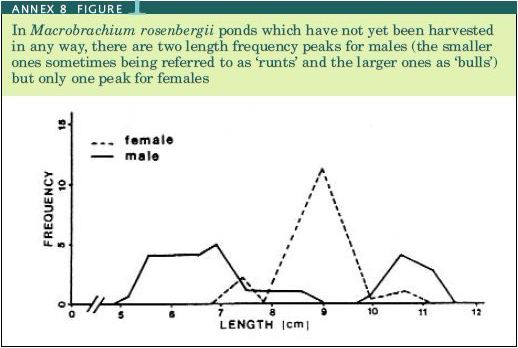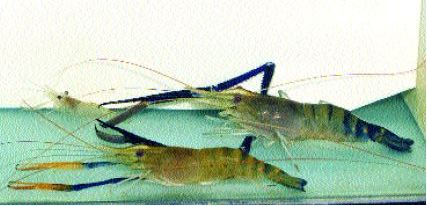1. Major male morphological characteristics
Firstly, it is necessary to understand what is meant by the various morphotypes. Three major morphotypes have been described for sexually mature male M. rosenbergii (Annex 8, Figure 2). The most immediately distinctive feature is the size and colour of the claws, and the robustness of their spines:
Blue claw males (BC) have extremely long blue claws (second pereiopods) with longer and stronger spines than OC males;
Orange claw males (OC) have golden coloured claws that are generally shorter and have shorter and less strong spines than those of BC males; and
Small males (SM) have small, slim, almost translucent claws.
There are also a number of intermediary forms between these major morphotypes. The transition from the small male (SM) to the orange claw (OC) morphotype is gradual. The OC is therefore sometimes referred to as the strong orange claw (SOC), and an inter mediate stage between these two forms, the weak orange claw male (WOC), has been rec ognized in research work. Another intermediate form, this time between the orange claw (OC) and the blue claw (BC) is known as the transforming orange claw (TOC); this is the last stage of the SOC male before it transforms into the BC male, as described later in this annex.
Karplus, Malecha and Sagi (2000) also describe some other external features which can be used to delineate the various morphotypes, such as the length and orientation of the spines on the claws, but these are less immediately obvious than claw colour and size. There are also a number of internal morphological and physiological differences, as well as
ANNEX 8 FIGURE1
In Macrobrachium rosenbergii ponds which have not yet been harvested in any way, there are two length frequency peaks for males (the smaller ones sometimes being referred to as ‘runts’ and the larger ones as ‘bulls’) but only one peak for females

SOURCE: FUJIMURA AND OKAMOTO (1972), REPRODUCED FROM NEW AND VALENTI (2000) WITH PERMISSION FROM BLACKWELL SCIENCE
differences in moult frequency. SM have relatively large testes that both produce and store sperm. The testes of BC serve mainly as a sperm reservoirs. The three orange claw male forms (WOC, SOC and TOC) represent a series of gradual changes between SM and BC. Firstly, the abundance of mature sperm found in the testes of SM declines and almost dis appears in the early OC stages. At the same time, the rate of production of spermatocytes (cells from which spermatozoa arise) increases as the SM moults into the OC phase. The OC phase is also characterized by frequent moulting. Another differential feature is the size (weight) of the midgut glands, especially the hepatopancreas. The hepatopancreas weight of the rapidly growing SOC is much greater than in all other morphotypes. The slow-growing SM and BC have the lowest relative midgut gland weight, while the WOC and the TOC males have intermediate values.
ANNEX 8, Figure 2
The major male morphotypes of Macrobrachium rosenbergii are called blue claw (BC), orange claw (OC), and small male (SM) (Israel)

SOURCE: ASSAF BARKI, REPRODUCED FROM NEW AND VALENTI (2000) WITH PERMISSION FROM BLACKWELL SCIENCE